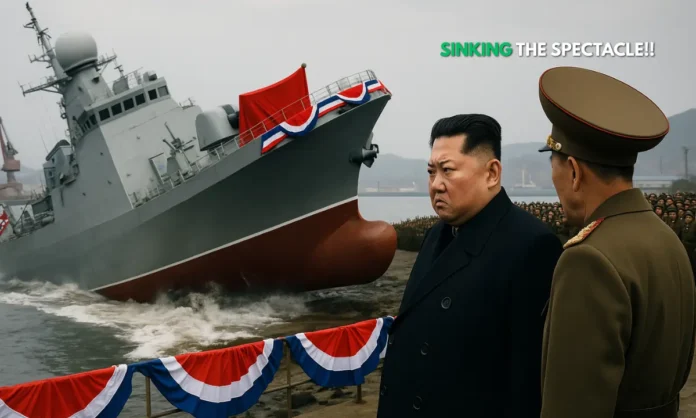Summary
- A 5,000-ton destroyer launch in Chongjin failed disastrously, crushing parts of the vessel’s hull and tipping it off balance.
- Kim Jong Un publicly condemned the failure as a “criminal act,” blaming ship designers and warning of consequences at the upcoming party plenary.
- The rare admission of a domestic military failure reveals internal cracks in North Korea’s high-stakes pursuit of naval modernization.
A Warship Tipped and a Regime Shaken
For a regime built on spectacle and military strength, failure is unforgivable. On Thursday, North Korea’s supreme leader Kim Jong Un personally witnessed the collapse—literally—of one of his regime’s proudest projects: a new 5,000-ton destroyer that tipped off balance during its launch in the eastern port of Chongjin. State media called it a “serious accident.” Kim called it “a criminal act.”
The bottom of the warship, designed to symbolize a new era in North Korea’s naval capabilities, was crushed. There were no reported casualties, but the symbolic damage was immense. This was not just a ship—it was a flagship of propaganda, intended to showcase North Korea’s ability to challenge the U.S. and South Korean navies.
In a stunning departure from usual secrecy, Kim Jong Un condemned the shipbuilders for “absolute carelessness, irresponsibility, and unscientific empiricism,” and ordered full restoration of the vessel before a major political meeting in June. For a country where even minor public dissent is taboo, this level of top-down rebuke suggests deeper institutional rot—and immense internal pressure.
🇰🇵 KIM JONG UN SLAMS ‘CARELESSNESS’ AFTER WARSHIP LAUNCH FAILURE IN FRONT OF HIM
— Mario Nawfal (@MarioNawfal) May 22, 2025
North Korean leader Kim Jong Un publicly rebuked military officials after a 5,000-ton destroyer malfunctioned during its launch—while he was watching.
State media KCNA reported Kim called the… https://t.co/HPcdJOLAyS pic.twitter.com/ZWACv27Mtn
The Vessel That Sank Before It Sailed
- The failed launch occurred in Chongjin, North Korea’s eastern naval hub.
- The 5,000-ton destroyer was touted as a leap in naval warfare, capable of deploying 70+ missiles.
- Kim had publicly praised the ship weeks earlier as a “breakthrough” in maritime military modernization.
- The launch mishap crushed the hull and destabilized the ship before deployment.
This warship wasn’t just another addition to North Korea’s navy—it was a prestige platform. The vessel, said to be capable of carrying more than 70 missiles, was positioned as the centerpiece of Kim’s push for maritime strength. It was introduced on the country’s west coast earlier this year with much fanfare, and the Chongjin launch was to be a dual deployment exercise.
Instead, what unfolded was a deeply embarrassing setback. Photos were not released, but sources confirm the bottom of the hull was crushed, making the destroyer structurally unstable. Engineers miscalculated stress factors or over-relied on flawed launch mechanisms, leading to a cascade failure during the ceremonial deployment.
Kim’s reaction was blistering. He described the incident as one that “severely damaged the dignity and pride of our nation in an instant.” And in North Korea, where optics matter as much as missiles, such failure is not just an error—it’s an ideological betrayal.
Fear, Accountability, and the State That Never Forgives
- Kim announced that those responsible would be punished at the June plenary meeting.
- In the past, failed projects have led to disappearances, demotions, or execution of officials.
- The state’s rare admission of failure signals that internal pressure may have reached a boiling point.
- Experts suggest the regime is attempting to restore domestic discipline and international image.
North Korea’s public acknowledgment of failure is exceedingly rare. In most regimes, this would be an embarrassing footnote. In Kim’s North Korea, it’s a political earthquake. The fact that Kim condemned the mishap so publicly signals that heads will roll—likely quite literally.
Though details of punishment were not disclosed, precedent offers a grim preview. Engineers involved in botched weapons or satellite launches have previously disappeared from public view. Others have faced hard labor or public shaming. In a state with one of the world’s worst human rights records, even minor infractions can lead to indefinite imprisonment—or worse.
The use of the term “criminal act” by Kim hints at trials or purges disguised as legal process. Activists warn that those involved may be used as scapegoats to deflect from systemic military inefficiencies. This also serves as a stark message to others within North Korea’s military-industrial complex: loyalty is not protection if you fail.
A Broken Hull, a Fractured Message
Kim Jong Un has built much of his legitimacy on the promise of military modernization—missiles, submarines, satellites, and now destroyers. Thursday’s launch disaster doesn’t just damage a ship; it punctures the illusion of unshakable momentum. It shows that even tightly controlled autocracies struggle with the same engineering realities and fallibilities as everyone else.
But unlike open societies, North Korea can’t risk appearing human. Each mistake becomes an existential threat to the regime’s narrative. By admitting the mishap and unleashing fury, Kim aims to reinforce the perception of control—but also betrays signs of unease. If the regime were confident, it would have buried the story. That it didn’t, suggests the consequences were too visible to hide.
As the June party plenary nears, attention will turn to how the regime salvages both the vessel and the narrative. Will Kim present a rebuilt destroyer to showcase resilience—or double down on ideological purity to explain engineering failure?
In either case, a launch that was meant to announce a new maritime chapter has instead opened a storm of accountability—and fear.


